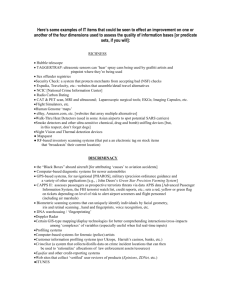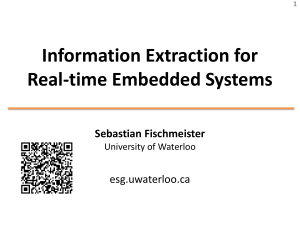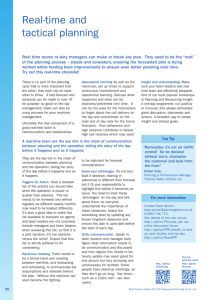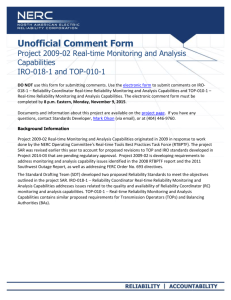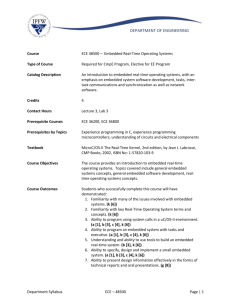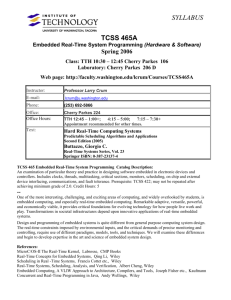PPT - CCSC - Consortium for Computing Sciences in Colleges
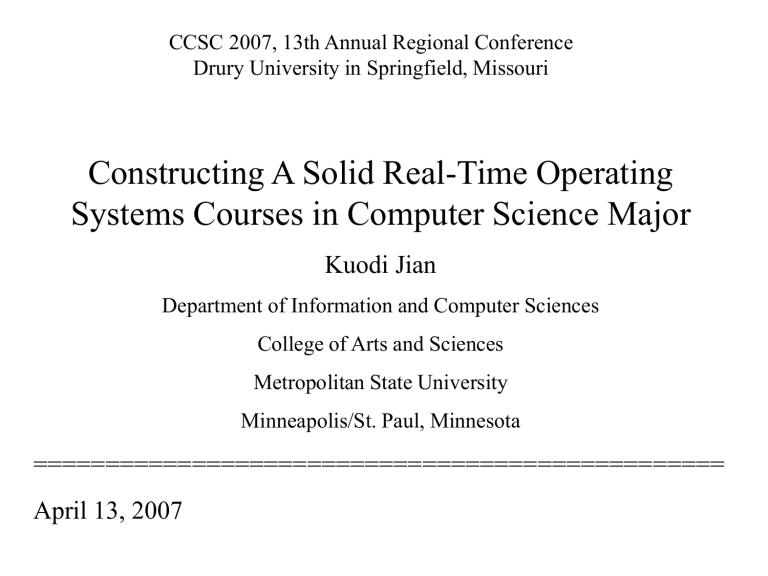
CCSC 2007, 13th Annual Regional Conference
Drury University in Springfield, Missouri
Constructing A Solid Real-Time Operating
Systems Courses in Computer Science Major
Kuodi Jian
Department of Information and Computer Sciences
College of Arts and Sciences
Metropolitan State University
Minneapolis/St. Paul, Minnesota
================================================
April 13, 2007
Introduction
This paper presents a way of constructing a solid realtime operating system course in a computer science major. It gives a complete course example (in terms of textbook selection, electronic equipment, and structuring the course materials to be covered) and points out aspects that you need to be aware when constructing a new Real-Time Operating System course for computer science students. The example course can be adapted to one semester graduate level course or one semester senior or junior levels undergraduate course.
Background
Students with a computer science major are weak in knowledge about computer hardware and electronics.
Typical undergraduate curriculum in computer science at a college or university in North America has inadequate coverage in computer hardware [1]. The only course that covers hardware in the curriculum is the Computer
Architecture and Organization. Usually, this course is being taught in such an abstract way and at a level away from the wires and computer chips that students have no idea about how computers really work at the hardware level.
Importance of Real-Time Systems
On the other hand, knowledge about real-time operating systems is quite useful. In today’s world, there are two orders of magnitude more embedded systems than PCs. It has been suggested that there are now as many embedded systems in everyday use as there are people on this planet. Examples of Real-Time Systems: cameras
DVD players cable descramblers cars airplanes factories offices hospitals
The rapid growth of embedded systems is generating demand for professionals who are able to design and to develop various kinds of embedded real-time systems.
The Pressure
Computer science departments in colleges and universities are feeling the increased demand for offering courses such as real-time systems, and real-time operating systems.
Lack of It
Currently, few universities and colleges offer Real-Time
Operating Systems courses in computer science department;
In the fall of 2005, an internet search resulted in the following related courses offered by the universities and colleges in the
US:
ECE 397-1: Introduction to Real-Time Systems, by Northwestern University
CS 431: Embedded Systems Architecture and Software, by University of
Illinois at Urbana-Champaign
CS 4220: Embedded Systems, by Georgia Tech
CS 445: Real-Time Systems, by University of Massachusetts Boston
CS 460: Embedded Systems, by Colorado State University
COP 4613-01/CIS 5930-05: Real Time Systems, by Florida State University
CS 589: Software Engineering for Embedded Systems, by Center for Software
Engineering
ECE/CS 750: Real-time Computing Systems, by University of Wisconsin-
Madison
Most above courses do not cover four layers, as mentioned in the next slide.
Four Real-time Layers
The paper by Zalewski argues that a complete and comprehensive picture of a real-time system knowledge unit must include elements of all four realtime layers [4]:
•System specification and design
•Host computer implementation
•Downloading and cross-testing on target with real-time kernel
•Testing on independent target with external hardware connections
A COMPLETE COURSE EXAMPLE
Textbook:
1. Michael J. Pont, “Embedded C”, Copyright 2002 Addison-Wesley, ISBN 0-201-
79523-X.
2. Sudhakar Yalamanchili, “VHSL Starter’s Guide & ACTV HDL6.3 Student Edition with CD”, Copyright 2005 Prentice-Hall, Inc, ISBN 0-13-218858-9.
3. Paul Scherz, “Practical Electronics for Inventors”, Copyright 2007 McGraw-Hill,
ISBN 978-0-07-145281-6.
4. (Optional) Jean J. Labrosse, “MicroC/OS-II, The Real-Time Kernel”, Copyright 2002
CMP Books, ISBN 1-57820-103-9.
Special Topics:
1. Special Topic on Getting Started with μVision2 and Debugging Using Simulator.
2. Special Topic on Keil’s 8051 Real-Time Operating System, RTX51 Tiny.
3. Special Topic on Hitex’s MX51 in-circuit emulator and chip writer, TopMax
Programmer.
4. Special Topic on Co-operative Schedulers.
5. Special Topic on MicroCOS, an Open Source Real-Time Operating System.
6. Special Topic on IntelliBrain Robot.
7. Special Topic on 32-bit ARM CPU.
A COMPLETE COURSE EXAMPLE CONT.
Lab Equipments
1. MetricTest’s GOS-620 2-channel oscilloscope.
2. Multi-meters (both analog and digital).
3. Hitex’s in-circuit emulator MX51-SE.
4. TopMax chip writer.
5. Keil’s evaluation board MCB 51.
6. IntelliBrain Robot.
7. Several instructor-made circuitry boards.
8. Easy ARM2200 educational board.
Labs
1. Lab 1: Communication between PC and hardware devices and window programming.
2. Lab 2: Use of electrical equipments and understand datasheets.
3. Lab 3: Blinky program for Keil’s MCB251 evaluation board.
4. Lab 4: Use in-circuit emulator and chip writer and understand datasheets.
5. Lab 5: Java programming on IntelliBrain Robot and understand Easy
ARM2200 educational board.
A COMPLETE COURSE EXAMPLE CONT.
Homeworks, Term Paper, Quizzes, and Project
1. There are 4 homework assignments.
2. There are 5 quizzes.
3. There is 1 term paper with 2 deliveries.
4. There is 1 project that is due at the end of the semester.
Tests
1. One comprehensive test given at two third of the semester.
Evaluation:
Homework (4)
Quizzes (4-5)
17% 3 * 50, 30,
15% 5 * 33 165
180
Take home labs (5)
Term paper
Project
Midterm
Total
19% 5 * 50
200
200
250
9.5% 100(40, 60)
19% 200
19% 200
100%
100
Text books and Special Topics
Three books are chosen for the course, in addition to another one that is optional. We choose multiple books because we must cover a wide range of topics that is the nature of this course. Since we assume the students have no hardware background, we have to offer some coverage on hardware. To be a meaningful Real-Time Operating System course, we cover different types of Real-Time Operating Systems. Also, to cover four layers, we must offer the knowledge of whole process of developing a software, debugging it (using in-circuit emulator), and then burning the program to a read-only memory chip.
When dealing with all the issues from different areas, it is nature that we use multiple textbooks and handouts that take the form of special topics.
Select VHDL as the simulation language
Hardware description language is a very important tool for modern real-time system developers to master. In this course, we choose the textbook VHSL Starter’s Guide
& ACTV HDL6.3 Student Edition with CD to cover this area.
Lab Equipments
The lab equipments listed here are not too expensive; most universities are able to buy them. Some lab boards are constructed by the instructor, and I should point out that it is not difficult to construct these boards.
Purchase of In-Circuit Emulator
One expensive and important equipment in this course is the In-circuit emulator. To get the right kind of in-circuit emulator is a daunting task. The products that we examined are:
Phyton’s PICE-52 and Hitex’s MX51-SE for the 8051 Microcontroller Family. After some experimenting, we decided to purchase the emulator from Hitex with a price tag of $2716 with an educational discount of $374 included.
Feedback From Students
The given example course has already been offered at spring of 2006 at the graduate level. The prerequisite for the course is that a student has been officially admitted to the graduate program, which means that an instructor can assume that the students have strong background in computing. The course received very positive feedbacks from the students. By the end of the course, students rated the satisfaction level 1.8 on a scale of 0-5 with 0 being the most satisfying.
CONCLUSIONS
We noticed some difficulties in constructing a Real-
Time Operating System course in a computer science department. The special requirements of real-time systems can be overwhelming to programmers new to the embedded world [7]. In this paper, we presented a solid course example that has been taught at the graduate level and received very positive feedbacks from the students. We presented the structure of our example course and gave the explanation on why the course is structured this way. Also, in this paper, we gave our advices on purchasing equipments.
Contact Information
Kuodi Jian
Email: kuodi.jian@metrostate.edu
Phone: 651-765-9603
Department of Information and Computer Sciences
College of Arts and Sciences
Metropolitan State University
700 East Seventh Street
St. Paul, MN 55106


